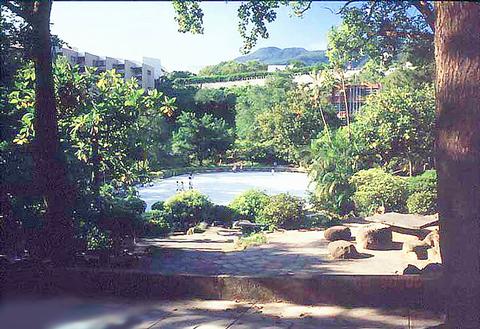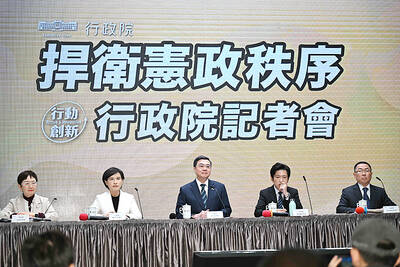With Taipei poised to build the city's first cable car system in Peitou District, cultural workers and local opposition leaders are going head-to-head with the city to voice their strong opposition to the plan.
While the city insists that the line is designed to ease traffic problems in Yangmingshan National Park and to boost the waning economy of Peitou District, opponents argue that it will do just the opposite.
"As a local resident, I don't appreciate the prospect of having our skyline marred by a cable car line combined with a mass of tourists coming here during the flower season," said Huang Kuei-kuan (

PHOTO: COURTESY OF LIVING ENVIRONMENT MAGAZINE
Huang and other opponents of the cable car system began their battle on July 18 when Taipei City Mayor Ma Ying-jeou (馬英九) officially expressed his intention to go ahead with the project and construct it using the BOT (built-operate-transfer) model -- meaning the city will team up with private contractors who will build the project, while the city provides the land, which it acquired for only NT$150 million. This is seen as the fastest and most cost-effective way to complete the project.
In an attempt to persuade the city to drop the project, opponents have launched an unofficial signature drive -- which has so far amassed over 3,000 individual signatures from local communities.
They also have sent out e-mails and used the media to make their voices heard.
In a bid to quell the antagonism, the city on July 31 gave an official presentation to outline the benefits of the project. A second presentation will be held tomorrow.
The project is one of the promises made by Mayor Ma during his election campaign and it seems that the city may eventually go ahead with it, one way or another.
The proposed line is 4.9km long, would cover 1.6 hectares over four boroughs, and is set to have four stops, with the starting point being at the skating rink located at the Chinshui Park (親水公園) in Hsin Peitou, continuing on to Lungfeng Valley (龍鳳谷) on Yangmingshan, the first parking lot in Yangmingshan National Park, and finishing off at the second parking lot.
The city hopes to complete the one-year, NT$1 billion project by the end of 2003.
The history of the project is a long one. It dates back to 1979 when then-Taipei mayor Lee Teng-hui (李登輝) abrogated prostitution in Peitou. Although the move eliminated over half of the notorious hot springs hotels where prostitution was conducted, it also endangered the area's economy.
The original plan
In a bid to boost the region's economy as well as to ease the traffic problem, Yangmingshan National Park Headquarters (YNPH, 陽明山國家公園) in 1989 commissioned a US-based research center, RHAA, to come up with possible solutions to these problems. One of the two alternatives the center proposed was to build a network of cable cars connecting the park with Peitou, Tienmu, Tamsui, and Niuputzu (牛埔子).
The YNPH in 1991 entrusted a Taiwan-based research company, Central Engineering Consultant and Research Inc (
Three possible routes were proposed: the first option would begin at Peitou Hot Spring Public Bath Pool (
The National Park Planning Committee, operating under the Ministry of the Interior later handed back the proposal to the park headquarters and requested the project be integrated with the mass rapid transit (MRT) system.
In response, then-mayor of Taipei Chen Shui-bian (
In 1998, the city's Bureau of Public Works (
Strong opposition
Although the city government claims that the cable car will ease traffic problems on Yangmingshan and help the economy of Peitou, cultural and historical workers hold a different view.
"How do you expect the traffic problem to be solved with one cable car line?" Huang said. "It's a bad idea because not only does it not solve Yangmingshan's traffic problem, it may transfer the problem to Peitou."
Neither does the cable car spur opportunities for the area's businesses, Huang said.
"What it really does is swiftly transfer people out of Peitou to Yangmingshan, instead of bringing them here to spend their money," she said, adding that the route also concerned her.
"It's not a good choice to start [the line] at the 87-year-old Chinshui Park, because it's so rich in history and is a favorite local gathering place ? The construction of the cable car line would sabotage the entire historical and ecological aspect of the park," she said.
As well, the squeaking noise of the cable lines may have a negative impact on teaching quality at Hsinmin Junior High School, which is below part of the route, she said.
Ecology and safety problems are another two of her concerns.
"The 26 colossal supporting pillars and the safety net below the line will not only be ugly, but won't blend in with the forest around it," she said. "The sulfurous fumes from the hot spring may also pose a threat to the machinery."
Instead, Huang said, cultural conservation is the ultimate way to attract tourists to Peitou and boost the area's economy.
"Haven't we seen more tourists coming here since the Peitou Hot Spring Museum was made accessible to the public?" she said, pointing out that the district has a total of 11 historic sites.
The museum was declared a national historic site in 1997 and was opened to the public the following year.
Chen Lin-sung (
"Do we really need the cable car? Will it really benefit local residents?" he asked. Chen also questioned the proposed fare, which he said is too high.
"Do you think people will spend a couple of hundred dollars just to visit four spots in Yangmingshan National Park, when the park actually has over 30 attractions?" he said.
Prices for a one-way ticket are slated at NT$100 per person during the flower season and NT$50 during off-season. In other words, a person will spend between NT$100 and NT$200 for a round trip, and the cost for a family of four would be between NT$400 and NT$800.
Chang Lu-wen (
He said his reasons are simple: half of the route would cover his borough -- which houses half of the district's hot spring hotels and eight of the district's 11 historic sites.
"We don't need to boost the economy here because it's already a prosperous place," he said. "What's wrong with keeping it the way it is, as a residential area?"
Robust rebuttal from the city
Although the city has shown sincerity in tackling the concerns of opponents of the project, said Hsu Cheng-ping (許正平), planning chief of the city's Bureau of Public Works, he said he is fed up with the constant whining from protagonists.
"They're rejecting something just because they have an opportunity to do so," he said. "They're so conservative that they think no development is the best development."
The opposing forces are not as strong as they seem, he said.
"I would like to make one thing clear here: most people have the impression that the majority of people are opposed to the idea, but it's not true. The reason is that those who approve of the idea don't feel the need to have their voices heard," he said.
To prove it, Hsu said 39 out of the district's 40 borough wardens approve of the project. In addition, three surveys administered by the bureau have shown that about 60 to 80 percent of local residents favor the project.
"We've been very flexible in terms of making adjustments to the plan," he said, adding that they have reduced the number of houses which would need to be demolished from 60 to 30, and moved the starting point, originally set at Chinshui Park, to the skating rink which is 100m west of the park.
As for the expensive fares, Hsu said, [the current prices] are just for the sake of reference.
"Everything is negotiable," he said. "We're just setting the ceiling for future contractors."
Hsu explained why the project does not require an environmental impact assessment, something that cultural workers have fiercely criticized.
"The Environmental Impact Assessment Law stipulates that no assessment is needed if the development area of a project is less than 4 hectares and the amount of soil dug up is less than 10,000m2," he said.
The project covers an area of 2.4 hectares and the amount of soil that would be have to be dug up is estimated at 5,000m2.
Hsu said that he personally does not care whether or not the cable car system is built.
"As a civil servant, I do what my superior tells me to do. It doesn't really matter to me whether the project is eventually realized. I won't get paid less for that, but the way that opponents are making waves really upsets me," he said.

The US government has signed defense cooperation agreements with Japan and the Philippines to boost the deterrence capabilities of countries in the first island chain, a report by the National Security Bureau (NSB) showed. The main countries on the first island chain include the two nations and Taiwan. The bureau is to present the report at a meeting of the legislature’s Foreign Affairs and National Defense Committee tomorrow. The US military has deployed Typhon missile systems to Japan’s Yamaguchi Prefecture and Zambales province in the Philippines during their joint military exercises. It has also installed NMESIS anti-ship systems in Japan’s Okinawa

‘WIN-WIN’: The Philippines, and central and eastern European countries are important potential drone cooperation partners, Minister of Foreign Affairs Lin Chia-lung said Minister of Foreign Affairs Lin Chia-lung (林佳龍) in an interview published yesterday confirmed that there are joint ventures between Taiwan and Poland in the drone industry. Lin made the remark in an exclusive interview with the Chinese-language Liberty Times (the Taipei Times’ sister paper). The government-backed Taiwan Excellence Drone International Business Opportunities Alliance and the Polish Chamber of Unmanned Systems on Wednesday last week signed a memorandum of understanding in Poland to develop a “non-China” supply chain for drones and work together on key technologies. Asked if Taiwan prioritized Poland among central and eastern European countries in drone collaboration, Lin

Renewed border fighting between Thailand and Cambodia showed no signs of abating yesterday, leaving hundreds of thousands of displaced people in both countries living in strained conditions as more flooded into temporary shelters. Reporters on the Thai side of the border heard sounds of outgoing, indirect fire yesterday. About 400,000 people have been evacuated from affected areas in Thailand and about 700 schools closed while fighting was ongoing in four border provinces, said Thai Rear Admiral Surasant Kongsiri, a spokesman for the military. Cambodia evacuated more than 127,000 villagers and closed hundreds of schools, the Thai Ministry of Defense said. Thailand’s military announced that

NO CONFIDENCE MOTION? The premier said that being toppled by the legislature for defending the Constitution would be a democratic badge of honor for him Premier Cho Jung-tai (卓榮泰) yesterday announced that the Cabinet would not countersign the amendments to the local revenue-sharing law passed by the Legislative Yuan last month. Cho said the decision not to countersign the amendments to the Act Governing the Allocation of Government Revenues and Expenditures (財政收支劃分法) was made in accordance with the Constitution. “The decision aims to safeguard our Constitution,” he said. The Constitution stipulates the president shall, in accordance with law, promulgate laws and issue mandates with the countersignature of the head of the Executive Yuan, or with the countersignatures of both the head of the Executive Yuan and ministers or